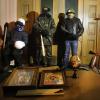Wednesday, January 29, 2014
Tuesday, January 28, 2014
What humans may have looked like 7,000 years ago: Hunter-gatherer roots, Paleo diet and some possible traces of African genes

A 7,000-year-old man from the Mesolithic Period had blue eyes and dark skin. (Pelopanton/CSIC)
Hunter-gatherer roots, Paleo diet and some possible traces of African genes
Related Content
 View PhotoA 7,000-year-old man from the Mesolithic Period had blue eyes and dark skin. (Pe …
View PhotoA 7,000-year-old man from the Mesolithic Period had blue eyes and dark skin. (Pe …
Dark skin. Blue eyes. Beard. Thin and borderline lactose-intolerant.
That's what scientists say man may have looked like 7,000 years ago, after studying DNA from bones discovered in a Spanish cave. The Mesolithic skeleton found at the La Brana-Arintero site in Leon in 2006 is thought to be the first recovered genome of a European from that period.According to a study published on Sunday in the journal Nature, pigmentation genes extracted from a tooth of the man — dubbed La Brana 1 — reveal he had dark skin like an African-American but the blue eyes of a Scandanavian, "suggesting the light skin of modern Europeans was not yet ubiquitous in Mesolithic times."
"The biggest surprise was to discover that this individual possessed African versions in the genes that determine the light pigmentation of the current Europeans," Carles Lalueza-Fox, a researcher from the Spanish National Research Council, said in a press release accompanying the findings.
While the man had dark skin, Lalueza-Fox said, "we cannot know the exact shade."
La Brana 1 was a hunter-gatherer subsisting on a low-starch diet and had trouble digesting milk.
"The arrival of the Neolithic, with a carbohydrate-based diet and new pathogens transmitted by domesticated animals, entailed metabolic and immunological challenges that were reflected in genetic adaptations of post-Mesolithic populations," the study noted. "Among these is the ability to digest lactose, which La Brana individual could not do."
But the 7,000-year-old also had an advanced immune system normally associated with modern Europeans, the study found.
The researchers added that more genome analysis is necessary from the Mesolithic Period to determine whether La Brana 1's looks were common. The group is preparing to study the remains of "La Brana 2," another male found in the same cave.
@YahooCanadaNews on Twitter, become a fan on Facebook
Monday, January 27, 2014
Thursday, January 23, 2014
Guardian and CBC of Canada blocked in China after story about leadership's offshore wealth
Access to the front page of newspaper's website blocked and availability of other stories intermittent. And Google search doesn't allow to go directly to the those media websites.
- Tania Branigan in Beijing
- theguardian.com,
- Jump to comments (196)
The Guardian appeared to be partially blocked in China on Wednesday after revealing that relatives of the country's top political and military leaders are making use of offshore companies in the Caribbean.
The report, based on leaked financial documents, showed that the brother-in-law of president Xi Jinping and son and son-in-law of former premier Wen Jiabao were among more than a dozen family members of current or former leaders using the offshore havens.
Repeated attempts to access the story from China failed without a virtual private network (VPN). Some attempts to reach The Guardian’s front page failed and access to other, unrelated stories was intermittent.
Earlier this month, The Guardian was briefly partially blocked before becoming accessible again.
The report that more than 21,000 clients from China and Hong Kong have made use of the Caribbean offshore havens is the latest revelation in a two-year initiative by the International Consortium of Investigative Journalists, which has shared leaked data from two companies in the British Virgin Islands with the Guardian and other international news organisations.
The website of the ICIJ could not be reached and the website of the Spanish newspaper El Pais, another of the media partners, also appeared to be inaccessible.
Australia’s Global Mail could be accessed, but not its story about the wealth. Reports on the holdings could be read in full on the websites of France’s Le Monde, Germany’s Suddeutsche Zeitung and Canada’s CBC News.
The wealth of Chinese officials and their families has become a subject of growing interest, particularly in light of Xi’s campaign for austerity and against corruption since becoming leader.
Chinese activists whose campaigns have included a push for financial transparency – holding street protests calling on officials to declare their assets – have faced a punishing crackdown. Xu Zhiyong, the best-known member of the New Citizens Movement, is standing trial in Beijing on Wednesday while other members of the movement will be tried on Thursday and Friday.
The websites of Bloomberg and the New York Times have been blocked in China since they reported on the onshore assets of relatives of leaders – including those of Xi and Wen – in 2012. They have also been unable to obtain visas for new reporters.
Austin Ramzy, who has worked on the mainland for several years and sought to transfer to the New York Times from another publication, will have to leave when his current visa runs out at the end of the month unless the authorities change course.
The report, based on leaked financial documents, showed that the brother-in-law of president Xi Jinping and son and son-in-law of former premier Wen Jiabao were among more than a dozen family members of current or former leaders using the offshore havens.
Repeated attempts to access the story from China failed without a virtual private network (VPN). Some attempts to reach The Guardian’s front page failed and access to other, unrelated stories was intermittent.
Earlier this month, The Guardian was briefly partially blocked before becoming accessible again.
The report that more than 21,000 clients from China and Hong Kong have made use of the Caribbean offshore havens is the latest revelation in a two-year initiative by the International Consortium of Investigative Journalists, which has shared leaked data from two companies in the British Virgin Islands with the Guardian and other international news organisations.
The website of the ICIJ could not be reached and the website of the Spanish newspaper El Pais, another of the media partners, also appeared to be inaccessible.
Australia’s Global Mail could be accessed, but not its story about the wealth. Reports on the holdings could be read in full on the websites of France’s Le Monde, Germany’s Suddeutsche Zeitung and Canada’s CBC News.
The wealth of Chinese officials and their families has become a subject of growing interest, particularly in light of Xi’s campaign for austerity and against corruption since becoming leader.
Chinese activists whose campaigns have included a push for financial transparency – holding street protests calling on officials to declare their assets – have faced a punishing crackdown. Xu Zhiyong, the best-known member of the New Citizens Movement, is standing trial in Beijing on Wednesday while other members of the movement will be tried on Thursday and Friday.
The websites of Bloomberg and the New York Times have been blocked in China since they reported on the onshore assets of relatives of leaders – including those of Xi and Wen – in 2012. They have also been unable to obtain visas for new reporters.
Austin Ramzy, who has worked on the mainland for several years and sought to transfer to the New York Times from another publication, will have to leave when his current visa runs out at the end of the month unless the authorities change course.


Sign up for the Guardian Today
Our editors' picks for the day's top news and commentary delivered to your inbox each morning.
Sign up for the daily emailMore on this story
-
China blocks foreign news sites which revealed elite's offshore holdings
Guardian and International Consortium of Investigative Journalists among sites blocked as China Digital Times publishes details of directive
Chinese oil giants make use of offshore shell companies in Caribbean
 China's elite using offshore haven
China's elite using offshore haven
Offshore secrets: British Virgin Islands
China's cash haven – the key points
China's elite: don't shoot the messenger
More from the Guardian

Yes, you can have a Chinese girlfriend and still be racist
17 Jan 2014

Russian socialite sparks outrage with 'racist chair' photograph
21 Jan 2014

China's cash haven in the British Virgin islands – the key points
22 Jan 2014

I'm halfway through an alcohol-free year. Could you do it?
21 Jan 2014

Yes, you can have a Chinese girlfriend and still be racist
17 Jan 2014

Russian socialite sparks outrage with 'racist chair' photograph
21 Jan 2014

China's cash haven in the British Virgin islands – the key points
22 Jan 2014

I'm halfway through an alcohol-free year. Could you do it?
21 Jan 2014
More from around the web

Peru: After the Commodity Boom
(The Financialist)

Amazon's Delivery Drones Could Be Sitting Ducks
(Bloomberg)

State Colleges, Universities Advised to Embrace Change
(Diverse Education)

Moto G by Motorola - A Google Company | MobileTechnologyTalk
(Mobile Technology Talk)

Peru: After the Commodity Boom
(The Financialist)

Amazon's Delivery Drones Could Be Sitting Ducks
(Bloomberg)

State Colleges, Universities Advised to Embrace Change
(Diverse Education)

Moto G by Motorola - A Google Company | MobileTechnologyTalk
(Mobile Technology Talk)
-
As you walk along the Sea of Galilee your faith come alive!
www.goisrael.com/bestdeals -
These 6 stocks put your retirement portfolio ahead of the income game.
wealthyretirement.com/Retirement - Cruise the World's Greatest Cities. 2-for-1 River Cruise
Cbc Blocked By China - News Results
 |
|
search results
- www.cbc.ca/news/world/china-blocks-cbc-
website-after-story-about... The websites of several major news outlets, including the CBC and the Guardian, have been blocked in China following worldwide stories about how relatives of current ... - www.theguardian.com/world/2014/jan/22/
guardian-blocked-china... Cached The Guardian appeared to be partially blocked in China on Wednesday after revealing that relatives of the country's top political and military leaders are making use ... - article.wn.com/view/2014/01/23/CBC_
website_blocked_in_China_after... Cached Newspaper Websites Blocked In China After Reports About Chinese Leaders' Wealth - news.ca.msn.com/world/report-links-
chinese-elite-to-offshore-tax... Cached China blocks CBC website after story about offshore accounts; Chinese leaders' riches cloaked in offshore tax havens, report says; China creates teams to ... - ca.sports.yahoo.com/news/japan-pm-may-
attend-sochi-games-china... Cached Japan's ties with China have recently deteriorated due to a series of disputes, ... CBC blocked by China; Target warns Canadians; Ron Jeremy Miley Cyrus; - todaynewsgazette.com/cbc-blocked-by-
china Cached CBC Blocked By China, The websites of several major news outlets, including the CBC, have been blocked in locations within China following yesterday's worldw.. - ca.rd.yahoo.com/.../news/cbc-sports-
plays-week-033101643--spt.html Cached This edition of CBC Sports plays of the week features an incredible save by Carter Hutton of the Nashville ... CBC blocked by China; Natalie Dormer ... - news.sympatico.cbc.ca/world/china_
blocks_nyt_website_over_wen... Cached China blocks NYT website over Wen story. CBC News The New York Times website has been blocked in China after a story speculating on the massive family wealth ... - ca.finance.yahoo.com/news/china-faucets-
market-double-2018... Cached China Faucets Market to Double by 2018 Says TechSci Research Press Release: Techsci Research – Wed, 22 Jan, 2014 5:30 AM EST - www.poynter.org/...on-offshore-leaks-
china-took-six-months-and-news... Cached Those partners include BBC Panorama, the CBC in Canada, The Guardian, ... (On Tuesday, The Guardian reported they’d been blocked, again, in China.)
More search results
Journalists Being Kidnapped, Hurt and Killed Must Stop
by: Ed Zintel
This has to stop. Going into the last week of the year, 48 journalists had been killed worldwide in 2013, according to the Committee to Protect Journalists (CPJ). Of those, 17 were murdered, 19 were killed in crossfire or combat and 12 were killed on dangerous assignment. On the plus side, it was a drop from the 73 journalists killed in 2012. Just last month, at least 51 journalists were attacked while covering political protests in the Ukraine capital of Kiev.
Several of the journalists were targeted by a riot police unit known as Berkut, which was preventing protesters from storming the presidential administration building, according to CPJ. Maryana Zakusilo, of Telekritika, said that Berkut police beat journalists even though they had valid press IDs, wore vests marked “Press,” and had identified themselves as reporters. Several reporters suffered injuries, including head wounds and broken limbs, from being hit by rocks, flash grenades, and gas pellets and others had their reporting equipment damaged. This has to stop. A week before the incident in Kiev, the Swedish government confirmed that two Swedish male journalists had been kidnapped in Syria by an unknown group.
They were kidnapped as they were trying to leave the country. The men’s reported abduction comes amid a string of kidnappings across Syria. Approximately 30 local and international journalists are currently missing in Syria, with several cases not being publicized at the request of family members and news outlets. A reported 52 journalists have been killed since Syria’s civil war began in early 2011. This has to stop.
On the same weekend in which the journalists were attacked in Kiev, the Tel Aviv-based Foreign Press Association reported that Israeli forces threw stun grenades and fired rubber-coated bullets at journalists covering clashes between protesters and Israeli security forces at the Qalandiya crossing, which connects the northern West Bank and Jerusalem. The report said that one rubber-coated bullet was fired at an Italian freelance journalist at eye level. “Fortunately the photographer was taking pictures at the time and the rubber bullet shattered the camera instead of his head,” the FPA report said. And, again, on that same weekend in early December, Philippine radio journalist Joas Dignos was fatally shot. Dignos was a local radio commentator, according to news reports, who often criticized local officials. This has to stop. In August 2013, CPJ marked the 1,000th journalist killed since the organization started keeping detailed records in 1992.
CPJ Executive Directive Joel Simon summed it up perfectly while speaking at the CPJ annual International Press Freedom Awards dinner in late November: “We should not have to depend on the willingness of journalists to risk their lives to bring us the news that we need.” Indeed, in a supposed civilized world, journalists should not have to fear for their lives in order to do their jobs. There should be some sort of cocoon that protects them from harm. Because, no matter where they’re from, their purpose is not to harm others. Of course, journalists who are reckless and unnecessarily put themselves in harm’s way are another story. But those are very rare cases, according to the CPJ. So, what can you, as a journalist—or anyone, for that matter—do to help protect journalists from being kidnapped, hurt, or killed while in the line of duty?
One way is to make a donation to the CPJ at cpj.org.
Harvard Business Review : In today's business environment, leaders are often expected to be authentic in the workplace and set an example for their employees
 | |||||||
| Be Yourself, But Carefully by Lisa Rosh and Lynn Offermann In today's business environment, leaders are often expected to be authentic in the workplace and set an example for their employees. Ill-timed or ill-conceived self-disclosure, however, can backfire. In this Harvard Business Review article, Lisa Rosh and Lynn Offermann encourage managers to carefully plan how they present themselves in business settings, so they can take advantage of candor without revealing too much. READ MORE » | |||||||
| |||||||
| |||||||
Subscribe to:
Posts (Atom)











